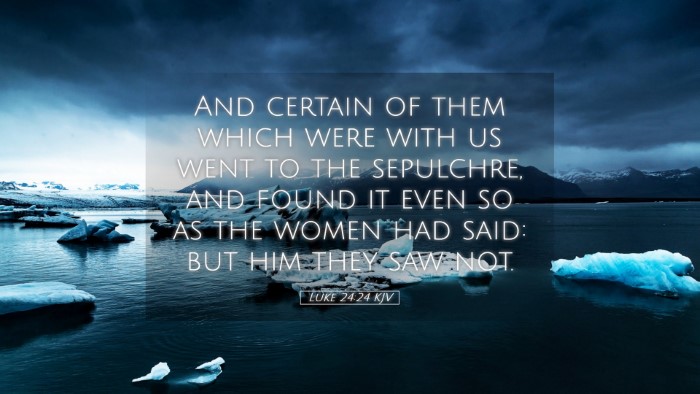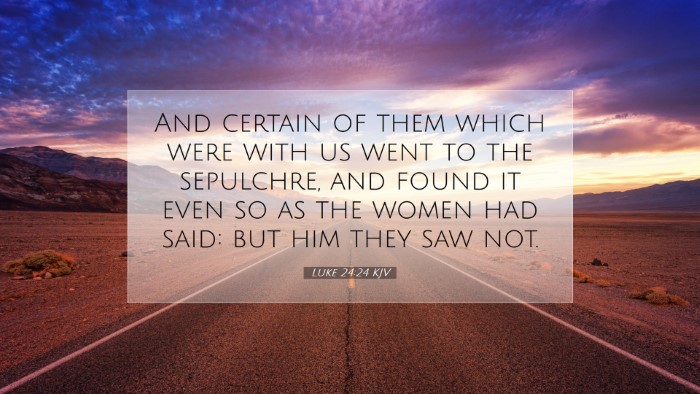Commentary on Luke 24:24
Bible Verse: "And certain of them which were with us went to the sepulchre, and found it even so as the women had said: but him they saw not."
Introduction
The account in Luke 24:24 is pivotal as it reflects the early responses to the women’s discovery of the empty tomb and emphasizes the disbelief surrounding the resurrection of Christ. This verse is a part of a larger narrative where the post-resurrection appearances of Jesus are gradually unfolding. Insights from various public domain commentaries will be discussed to enrich the interpretation and application of this passage.
Historical Context and Analysis
In the context of Luke’s Gospel, this verse occurs on the day of resurrection. The knowledge of Christ’s resurrection was initially communicated by the women who visited the tomb and encountered angels. Their testimony evokes varying responses among the disciples and followers of Jesus.
-
Albert Barnes Commentary:
Barnes highlights the incredulity of the disciples, underscoring how their natural skepticism is a recurring theme. The phrase "found it even so" indicates that the men who went to the sepulchre found everything aligned with the women’s account—specifically, the absence of Christ’s body. Despite this, their earlier conviction in resurrection is challenged by their visual experience of the empty tomb.
-
Matthew Henry’s Commentary:
Henry offers a theological exploration reflecting on faith and witnesses of the resurrection. He notes that even after the women testified to Christ's resurrection, some disciples remained unconvinced. He articulates how this illustrates the struggle of human belief in divine realities and that even firsthand testimony might not suffice to convince those with doubts.
-
Adam Clarke's Commentary:
Clarke elaborates on the specifics of the resurrection narrative, emphasizing the significance of the women as the first witnesses. He brings forth the idea that the report of the empty tomb must not only be understood contextually but also seen as a profound truth foundational to Christian doctrine. This serves to highlight the early church’s challenges in propagating the resurrection message amidst skepticism.
Theological Themes
This passage touches on several crucial theological themes:
-
Faith vs. Doubt:
This verse reveals the human condition regarding faith. Even when evidence is available, belief requires a heart willing to trust in the divine. The fact that the disciples went to the tomb illustrates a search for truth, yet their inability to comprehend the full implications of the event reinforces the struggle of faith.
-
Witnesses of the Resurrection:
The women’s role in the resurrection story is of paramount importance, as their testimony initially leads the men to verify the reality of Christ’s resurrection. It underscores the inclusion of marginalized voices in the gospels, highlighting their vital position within the early church.
-
The Nature of True Witness:
This verse points out that mere observation does not equate to understanding. The witnesses found the tomb empty—a fact—and yet did not see the risen Christ, which suggests that the fullness of the resurrection experience extends beyond mere external verification.
Practical Applications
For pastors, students, and scholars, Luke 24:24 invites reflection on the necessity of faith in unseen realities. Here are some practical applications:
-
Encouragement in Doubt:
Many believers face times of doubt. This passage serves as an assurance that the journey toward belief often includes struggles. Pastoral care can focus on providing a safe space for such struggles, encouraging eventual encounters with the risen Christ.
-
Valuing Testimonies:
In a modern context, it is essential to honor those who bear witness to their encounters with the divine. Pastors should encourage sharing testimonies within congregations, as these can fortify faith and serve as reminders of God’s presence and actions.
-
Study of the Resurrection:
Engagement with the resurrection narrative should be rooted deeply in academic study and personal faith experiences. Scholars are invited to analyze the responses depicted in the New Testament narratives, exploring how these dynamics play out in contemporary faith communities.
Conclusion
Luke 24:24 is a profound reminder of the multifaceted reactions to the resurrection of Christ, illuminating the human experience of doubt and belief. As we reflect on this text, the insights drawn from historical commentaries can enhance our theological understanding and pastoral practice, fostering a deeper appreciation for the risen Savior and encouraging a community grounded in faith despite uncertainties.


